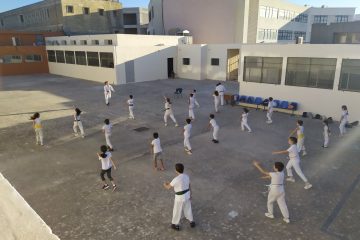Have you ever felt so much enthusiasm that you want to shout and tell everyone what you do? Or on the other hand, kind of bored to the point that you question whatever you do??
Well, let me rest your mind, this is very normal and it does not mean that either you have become addicted, or that you lost all interest.
This is a normal process in maturing through an activity and this happens due to fluctuations in what is called Motivation.
This is quite a vast subject and can hardly be discussed on paper, and it is by no means written to encourage or discourage anyone, but to give a very basic explanation on what is motivation, and on how/why it can affect our actions and decisions (in this case in Karate-Do but can be applied to any other activity).

So What Is Motivation?
The word Motivation refers to “factors that Activate, Direct & Sustain goal-directed behavior. Motives are the ‘whys’ of behavior – the needs or wants that drive behavior & explains what we do.” (Nevid, 2013)
Not everyone is motivated by the same type of activities or things, however, since this article will be in relation to Karate-Do, I will be assuming that people reading it are very interested in Karate, started practicing karate or have a number of years of experience.
What are the Components of Motivation?
The main ones are
- Activation
- Persistence
- Intensity
‘Activation’ involves the decision to start a behaviour or process and a set of goals (e.g. start practising karate-do, but could also be focusing on learning something more in detail e.g. better technique).
‘Persistence’ is the ongoing effort to achieve the Goals set (no matter the size of the goal, could actually be something big like starting training or something on a smaller scale like keep trying to perfect one single technique by focusing on a single point – such as the fingers during punching)
‘Intensity’ is the concentration or energy one puts to achieve the goals (e.g. someone might train once a week which is enough to achieve personal goals, another person might practice every day to be able to reach his/her goals)
These 3 factors are equally important for a person to keep performing and training, however, one has to understand that they are constantly changing and will Not always be present at the same level.
I will be giving very general examples to simplify the idea of the constant changes in these 3 factors, taking karate as the chosen activity;
Janice decides to start practising for a personal reason (for self-defence; fitness; because she simply likes it) – Activation
Months pass and Janice continues because she feels that training is being very beneficial to her and is fulfilling her needs (e.g. making her feel better about herself) even though she has less time to spend on other things – Persistence
Since it is making her feel so good, she decided to take up more classes and starts to train 4 times a week instead of 2 – Intensity
Some more months pass and Janice realizes that at the moment she cannot practice 4 times a week because she has studies which have to be done. Therefore, she decides to keep practicing once a week instead of 4 times – so now she decreased the Intensity but still Persisted to train because she believes that it is still beneficial for her to keep going even if it has to be at a minimum level.
Another example is this;
Ben has been training for a number of years and his goals were focused on achieving black belt level – Activation.
Now, after all these months/years of constant training – Persistence and Intensity – it has been some months since he graded and got his black belt. All of a sudden he starts to feel that he has lost the motivation for training and decides to start training twice a week instead of every day to make time for other things he might want to do.
Some more time pass and realizes that actually he only has been training to attain one result (black belt), and now decides that he wants to deepen his understanding but still decides to keep training twice a week instead of every day – Persistence at a lower Intensity.
The idea of these 2 scenarios is to show different circumstances and how fluctuations in these factors can lead to different decision making.
Now I will move on to How Can Motivation affect decisions?
One can notice that the general Motivation in both cases changed, and it could either be due to unpredictable changes in life such as in the first case, or could be simply because we feel we have lost interest, like the second case.
Based on Motivation, they could both have decided to stop training since the motivation for training dropped. However, Janice still saw that training would be beneficial for her which gave her enough personal motivation, and after thinking it through decided that she could keep performing at an intensity that suited her lifestyle at the time. Ben felt that he achieved his primary goal and decided to decrease the intensity of training until he sets new goals (such as learning more in-depth or simply train for personal satisfaction).
In these two scenarios there are no good or bad, but decisions based on personal goals. We are continually faced with situations that put us in a position where we have to make choices or take decisions.
Many people call these situations ‘obstacles’ or ‘problems’; however, a problem is not really The problem. The Attitude towards the obstacle is generally the problem. One may think that s/he has lost Motivation towards Karate when faced with a difficult decision, but in reality, Motivation would have fluctuated.
Persons that have chosen Karate-Do and keep performing it as a martial art for months or years, probably do so because they would have found something that enriches their lifestyle (apart from other reasons which can be different for everyone) & the key for this could be found if one looks into the Dojo Kun.
This goes to show that decisions are best not based on Motivation since this could lead to regret or disappointment later on. One has to be very careful and needs to understand that fluctuations are a normal part of development.

And this leads to another question: How can Motivation be increased when it’s low?
(Obviously, I am not addressing High Motivation, because when we are motivated we do not need any explanations really J)
There are many ways to work on Motivation. However, first we have to understand that there are basically 2 types:
Extrinsic Motivation (comes from outside of us) and Intrinsic Motivation (comes from within the person).
The focus should be on nurturing intrinsic motivation, however, during many stages in our journey, we will require both because when our ‘personal energy’ is at a low, seeing/ talking/ training with someone else might give us the required boost (& that is why training at a club is important). The important thing here is not to end up relying constantly on this Extrinsic Motivation because when it is not available one will obviously feel demotivated.
On the other hand, Intrinsic Motivation could be available more easily, since it is found within everyone. Having said this, one has to be aware that this kind of motivation needs to be patiently & gradually developed. Sometimes it will be very present and strong (and that is when we feel very good about what we do) but at other times it may be very low (and that is generally when we feel indecisive or not improving and may start to Think too much).
When motivation is ‘low’, persistence comes in to play a lot. During this time, it might also be a good idea to just flow through and train without any extra thought.
Setting very simple goals (such as keeping low stance and nothing else) will help in keeping focused without any extra thoughts.

The idea is that when one is going through a phase of high motivation one tries to focus on as many points as possible, and when motivation is low or feeling overloaded with thoughts (which actually may hinder development) it would be good to let go of everything, and just for a little time, allow ourselves to be open to external sources of motivation or simply rest the mind.
It is important to keep in mind that any decision taken with caution, thought and reflection can never be a bad decision and when feeling overloaded with ideas and thoughts (which may actually be hindering our progress) it would be wise to seek advice from someone with more experience. This will help us make a more informed decision.
Just to conclude I will leave this image as a guide for simple reflection, which every now and again could be helpful in our everyday life.

Christina Desira
Physiotherapist
3rd Dan Shotokan Karate – JKA
You can find a PDF version of this article here.


